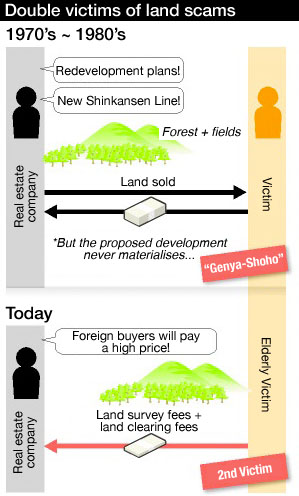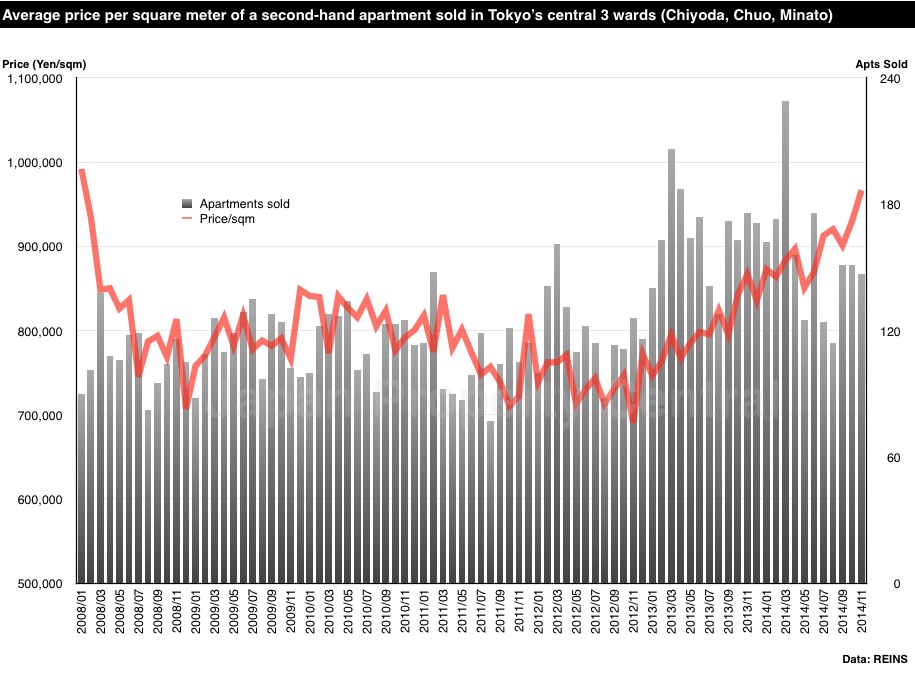Historic Japanese villa in NY looking for new home in Japan
 The current owner of a historic traditional Japanese house in upstate New York wants to relocate the home to Japan and is seeking a new owner.
The current owner of a historic traditional Japanese house in upstate New York wants to relocate the home to Japan and is seeking a new owner.
The ’Pine and Maple Palace’ was initially exhibited at the St. Louis World Fair in 1904. It was modelled in a style of architecture dating from the Momoyama period (late 1500s), but with some western features. After the fair, Emperor Meiji donated the villa to Dr. Jokichi Takamine, a successful chemist who had emigrated to the US. Takamine relocated the villa to his summer home in upstate New York. In 1909, Prince Kuni Kuniyoshi and Princess Kuni stayed in the villa during a visit to the US. The house was sold upon Takamine’s death in 1922. Read more
November rental data - Tokyo Kantei
According to Tokyo Kantei, the average monthly rent of a condominium apartment in greater Tokyo was 2,560 Yen/sqm in November, down 1.6% from the previous month but up 0.3% from last year. This is the first time in five months to see a month-on-month decline in rent. The average apartment size was 59.90 sqm and the average building age was 19.5 years.
The average monthly rent in Tokyo’s 23-ku was 3,199 Yen/sqm, down 1.1% from the previous month but up 2.8% from last year. The average apartment size was 56.76 sqm and the average building age was 17.7 years. Although rents across all areas within Tokyo have started to weaken, they are still hovering around the 3,200 Yen/sqm range.Read more
Tokyu Plaza Shibuya to be redeveloped

The Tokyu Plaza Shibuya building to the west of Shibuya Station will be demolished in 2015 and replaced with a larger mixed and retail development.
The 9-storey multi-tenant retail building, which was originally called the Shibuya Tokyu Building, opened in 1965. In celebration of its 50 year history, a number of stores will be holding special sales from January to March 2015, while some of the restaurants which have been in operation since the building opened will prepare special menu items. A temporary gallery with photos of the Shibuya area over the past five decades is also scheduled to open from the end of January.Read more
Central Tokyo apartment sale prices reach highest level in 7 years
According to REINS, 2,830 second-hand apartments were sold across greater Tokyo in November, up 6.6% from the previous month but down 9.3% from last year. This is the 8th month in a row to see a year-on-year decline. The average apartment sale price was 28,080,000 Yen, down 0.1% from the previous month but up 5.6% from last year. The average price per square meter was 441,500 Yen, up 1.4% from the previous month and up 7.1% from last year. This is the 23rd month in a row to see a year-on-year increase. The average building age was 20.04 years.
1,431 second-hand apartments were sold in the Tokyo metropolitan area, up 10.2% from the previous month but down 7.1% from last year. This is also the 8th month in a row to see a year-on-year decline. The average sale price was 34,080,000 Yen, down 2.0% from the previous month but up 5.2% from last year. The average price per square meter was 575,800 Yen, down 1.5% from the previous month but up 6.3% from last year. The average building age was 19.20 years.
In central Tokyo's 3 wards (Chiyoda, Chuo and Minato), the average sale price was 966,600 Yen/sqm, up 4.0% from the previous month and up 11.5% from last year. This is the highest price seen since January 2008 when prices were 991,900 Yen/sqm.Read more
Realtor sued after promising landowners they could sell worthless land to Chinese buyers at inflated prices
 114 landowners are seeking damages from an Osaka-based real estate company after claiming that they were encouraged to pay for land survey fees with the premise that they could sell their otherwise worthless forest land to Chinese buyers for high prices.
114 landowners are seeking damages from an Osaka-based real estate company after claiming that they were encouraged to pay for land survey fees with the premise that they could sell their otherwise worthless forest land to Chinese buyers for high prices.
On November 28, a class-action lawsuit seeking 47 million Yen (390,000 USD) in damages was filed in the Osaka District Court against 13 employees of Mirai Tochi Corporation and two other related companies. According to the complaint, 114 people aged from 35 to 89 from across Japan were approached by the company between 2011 and 2014. They allege that they were encouraged to pay the company as much as 300,000 ~ 700,000 Yen in land survey and maintenance fees with the hope that the land could then be sold to Chinese buyers.
The company is also currently being prosecuted for fraud in the Nara District Court. According to the Nara prefectural police, the case, which also includes their predecessor Toshow Management, involves damages exceeding 1.36 billion Yen (11.3 million USD) and 5,000 victims in 36 prefectures across the country and overseas.Read more
Supply shortage in central Tokyo sees apartment prices up 40% from market bottom
The price of secondhand apartments in Tokyo is rising, with prices in some areas exceeding those seen in the mini-bubble in 2007. In Tokyo’s 23 wards, the average asking price of a 70 sqm in October 2014 was 42,560,000 Yen, up 8.5% from the low of 39,220,000 Yen seen in July 2012.
One of the main drivers behind the rising prices is the shortage in the supply of brand new apartments. Following the Lehman Shock (or global financial crisis), a number of small-to-medium sized developers filed for bankruptcy. This has left the market controlled by a small number of Japan’s top developers. Prior to the Lehman Shock, the annual supply of brand new apartments reach 80,000 units. In 2014, it has almost halved to around 40,000 units. Buyers, who have not been able to find new apartments in their desired area, have turned to the secondhand market which has reduced supply even further. In the central Tokyo area, there are only half as many apartments on the re-sale market than there were in 2011. Read more
Residential yields and vacancy rates in Minato-ku - December 2014

According to real estate listing site Homes, the average gross yield on an apartment in Minato-ku in December was 5.9%, up 0.6 points from the previous month but down 0.1 points from last year. The average gross yield across Tokyo was 6.8%, down 0.1 points from the previous month and down 0.8 points from last year.
The vacancy rate remains unchanged at 9.9% in Minato-ku and 11.0% across Tokyo.
The average asking price of a secondhand apartment in Minato-ku was 833,542 Yen/sqm as of December 1, up 3.8% from the previous month and up 16.5% from last year. The average asking price for land was 1,258,787 Yen/sqm, down 1.1% from the previous month but up 17.5% from last year.Read more


